Drivers’ Perspective on Traffic Safety and Impacts from the Surrounding Landscape: A Case Study of Serbia
Abstract
1. Introduction
1.1. Influence of Landscape and Climatic Elements on Driving
1.2. Influence of the Specific Key Engineering Features on Driving
1.3. The Aim of the Research
- Which highway characteristics (both engineering and technical and those related to the surrounding landscape) influence drivers’ perceptions of road traffic safety the most?
- To what extent are drivers aware of how the surrounding landscape affects road safety?
- Do drivers perceive road traffic safety on highways differently as a result of gender and years of driving experience and type of vehicle?
2. Materials and Methods
2.1. The Study Area
2.2. Survey Methodology and Data Analysis
2.2.1. The Questionnaire Structure
2.2.2. Statistics Evaluations
2.2.3. Traffic Accident Access Estimations
3. Results
3.1. Respondent Data
3.2. Traffic Safety Assessment in the Research Area
3.3. Traffic Safety Through the Prism of Driver Perception
3.4. Observing Traffic Safety in Relation to Gender
3.5. Observing Traffic Safety in Relation to the Years of Driving Experience
3.6. Observing Highway Traffic Safety in Relation to the Category of Motor Vehicle
3.7. Observing the Highway Traffic Safety in Relation to the Influences of the Surrounding Landscape
3.8. Observing Traffic Safety in Relation to WEB GIS Application
4. Discussion
4.1. Traffic Safety Through the Planning Act Systems
4.2. Drivers’ Perspective on Traffic Safety Through Technical Elements
4.3. Drivers’ Perspective on Traffic Safety Regarding the Influences of the Surrounding Landscape
4.4. Sustainability Aspects of Traffic Safety and Driver Perceptions
4.5. Limitations of the Study and Suggestions for Future Research
5. Conclusions
- Drivers consider cracks in the road surface, wind and snow impact, sun reflection, and animals crossing the highway as factors that reduce their safety while driving;
- Drivers provided inconsistent responses regarding safety—initially rating the highway as safe, but later offering negative feedback when elaborating on their safety concerns. This suggests that drivers’ awareness is not at an adequate level. Lawmakers should take this into account to ensure that engineers have the necessary flexibility when designing highways to address these nuanced safety perceptions;
- All drivers, regardless of gender (exception is that men have a slightly more favorable attitude than women), age, or mode of transportation, share a similar view on safety, indicating the same level of unawareness.
Author Contributions
Funding
Institutional Review Board Statement
Informed Consent Statement
Data Availability Statement
Acknowledgments
Conflicts of Interest
References
- Elvik, R. Why some road safety problems are more difficult to solve than others. Accid. Anal. Prev. 2010, 42, 1089–1096. [Google Scholar] [CrossRef] [PubMed]
- Ziakopoulos, A.; Yannis, G. A review of spatial approaches in road safety. Accid. Anal. Prev. 2020, 135, 105323. [Google Scholar] [CrossRef] [PubMed]
- Fric, S.; Ilić, V.; Trpčevski, F. Driver-vehicle-environment system and modern road design. In Proceedings of the First Serbian Road Congress, Belgrade, Serbia, 5–6 June 2014; Vujanić, M., Vuksanović, B., Eds.; The Serbian Road Society: Belgrade, Serbia, 2014. [Google Scholar]
- Topolšek, D.; Babić, D.; Fiolić, M. The effect of road safety education on the relationship between Driver’s errors, violations and accidents: Slovenian case study. Eur. Transp. Res. Rev. 2019, 11, 18. [Google Scholar] [CrossRef]
- Karapetrović, J.; Jolović, D. Improvement of current anti-corruption measures for traffic safety development. In Proceedings of the Second Serbian Road Congress, Belgrade, Serbia, 9–10 June 2016; Mladenović, G., Andrić, I., Eds.; The Serbian Road Society: Belgrade, Serbia, 2016. [Google Scholar]
- WHO. Global Status Report on ROAD Safety 2022, Time for Action; World Health Organization: Geneva, Switzerland, 2022; Available online: https://www.who.int/publications/i/item/9789240086517 (accessed on 13 March 2023).
- Wegman, F. The future of road safety: A worldwide perspective. IATSS Res. 2017, 40, 66–71. [Google Scholar] [CrossRef]
- PIARC Strategic Plan 2024–2027. STRATEGIC PLAN 2024–2027 PIARC—THE WORLD ROAD ASSOCIATION. World Road Association (PIARC), France. Available online: https://www.piarc.org/ressources/documents/source/Strategic-Plan-PIARC-World-Road-Association-2024-2027/10390f51-42980-Strategic-Plan-2024-2027-PIARC-World-Road-Association-December-2023.pdf (accessed on 17 January 2025).
- FERSI-Towards Safer Roads in Europe. Available online: https://fersi.org/wp-content/uploads/2019/02/140512-Towards-safer-roads-in-Europe_final.pdf (accessed on 17 January 2025).
- ETSC-18th Annual Road Safety Performance Index (PIN Report). Available online: https://etsc.eu/18th-annual-road-safety-performance-index-pin-report/ (accessed on 19 January 2025).
- European Commission—Fact Sheet, 2019. 2018 Road Safety Statistics: What Is Behind the Figures? Available online: https://ec.europa.eu/commission/presscorner/detail/pl/MEMO_19_1990 (accessed on 26 December 2023).
- European Commission. Facts and Figures Main Figures. European Road Safety Observatory. Brussels, European Commission, Directorate General for Transport. 2024. Available online: https://road-safety.transport.ec.europa.eu/document/download/cd2dd292-4776-4b6c-9b89-212dc646907a_en?filename=ff_main_figures_20240315.pdf (accessed on 13 May 2024).
- ITF-International Transport Forum. 2022. Road Safety Annual Report 2022. France: The International Traffic Safety Data and Analysis Group (IRTAD). Available online: https://www.itf-oecd.org/sites/default/files/docs/irtad-road-safety-annual-report-2022.pdf (accessed on 4 April 2024).
- Svenson, O.; Fischhoff, B.; MacGregor, D. Perceived driving safety and seatbelt usage. Accid. Anal. Prev. 1985, 17, 119–133. [Google Scholar] [CrossRef] [PubMed]
- UN. 2023—UN News Global Perspective Human Stories: Extreme Weather Caused Two Million Deaths, Cost $4 Trillion over Last 50 Years. Available online: https://news.un.org/en/story/2023/05/1136897 (accessed on 30 May 2024).
- WBG—The World Bank Group. A Stronger, Connected, Solutions World Bank Group: An Overview of the World Bank Group Strategy. World Bank Publications—Books, The World Bank Group, Number 16093. 2019. Available online: https://documents1.worldbank.org/curated/en/602031468161653927/pdf/816970WP0v10WB0Box0379842B00PUBLIC0.pdf (accessed on 28 March 2024).
- UN—A/RES/74/299. Resolution Adopted by the General Assembly: Improving Global Road Safety, 2022. 74th Session, Agenda Item 12, United Nations. Available online: https://digitallibrary.un.org/record/3879711/files/A_RES_74_299-EN.pdf (accessed on 27 December 2024).
- Williams, A.F.; Paek, N.N.; Lund, A.K. Factors That Drivers Say Motivate Safe Driving Practices. J. Saf. Res. 1995, 26, 119–124. [Google Scholar] [CrossRef]
- Williams, A.F. Views of U.S. drivers about driving safety. J. Saf. Res. 2003, 34, 491–494. [Google Scholar] [CrossRef] [PubMed]
- Waard, D.; Jessurun, M.; Steyvers, F.J.J.M.; Reggatt, P.; Brookhuis, K. Effect of road layout and road environment on driving performance, drivers’ physiology and road appreciation. Ergonomics 1995, 38, 1395–1407. [Google Scholar] [CrossRef]
- Daniels, S.; Martensen, H.; Schoeters, A.; Vanden Berghe, W.; Papadimitriou, E.; Ziakopoulos, A.; Kaiser, S.; Aigner-Breuss, E.; Soteropoulos, A.; Wijnen, W.; et al. A systematic cost-benefit analysis of 29 road safety measures. Accid. Anal. Prev. 2019, 133, 105292. [Google Scholar] [CrossRef] [PubMed]
- Yan, J.; Zeng, S.; Tian, B.; Cao, Y.; Yang, W.; Zhu, F. Relationship between Highway Geometric Characteristics and Accident Risk: A Multilayer Perceptron Model (MLP) Approach. Sustainability 2023, 15, 1893. [Google Scholar] [CrossRef]
- Perry, A.; Symons, L. The wind hazard in the British Isles and its effects on transportation. J. Transp. Geogr. 1994, 2, 122–130. [Google Scholar] [CrossRef]
- Edwards, J. Weather-related road accidents in England and Wales: A spatial analysis. J. Transp. Geogr. 1996, 4, 201–212. [Google Scholar] [CrossRef]
- Williamson, A.; Friswell, R.; Olivier, J.; Grzebieta, R. Are drivers aware of sleepiness and increasing crash risk while driving? Accid. Anal. Prev. 2014, 70, 225–234. [Google Scholar] [CrossRef] [PubMed]
- Lanphear, F.O. Aesthetics of Highway Design. 1967. Available online: https://docs.lib.purdue.edu/cgi/viewcontent.cgi?article=3152&context=roadschool (accessed on 27 December 2024).
- Sentić, I.; Đorđević, T.; Đorđević, J.; Ljubojević, M.; Čukanović, J. Understanding the influence of climate elements on traffic: The wind impact approach. Theor. Appl. Climatol. 2022, 149, 661–681. [Google Scholar] [CrossRef]
- Antonson, H.; Mårdh, S.; Wiklund, M.; Blomqvist, G. Effect of surrounding landscape on driving behaviour: A driving simulator study. J. Environ. Psychol. 2009, 29, 493–502. [Google Scholar] [CrossRef]
- Horneback, P.L.; Forster, R.R.; Dillingham, M.R. Highway Aesthetics-Functional Criteria for Planning and Design in Highway Research Record. Roadside Dev. 1969, 250, 25–38. [Google Scholar]
- Yao, X.; Ji, B.; Mingda, L.; Yuzhuo, M.; Xin, J. Research on the Impact of Road Landscape Color on the Driving Fatigue of Drivers. IOP Conf. Ser. Earth Environ. Sci. 2020, 440, 042044. [Google Scholar] [CrossRef]
- Talbot, R.; Filtness, A.; Morris, A. Proposing a framework for evidence-based road safety policy-making: Connecting crash causation, countermeasures and policy. Accid. Anal. Prev. 2024, 195, 107409. [Google Scholar] [CrossRef] [PubMed]
- PWC. A Guide for Policy Makers: On Reducing Road Fatalities, 2017. Loughborough University. 2017. Available online: https://www.pwc.com/m1/en/publications/road-safety/pwc-guide-on-reducing-road-fatalities.pdf (accessed on 27 December 2024).
- Pérez de la Cruz, L.J.; Conejo-Muñoz, R.; Morales-Bueno, R.; Puy-Huarte, J. Highway design by constraint specification. Artif. Intell. Eng. 1995, 9, 127–139. [Google Scholar] [CrossRef]
- Rowden, P.; Matthews, G.; Watson, B.; Biggs, H. The relative impact of work-related stress, life stress and driving environment stress on driving outcomes. Accid. Anal. Prev. 2011, 43, 1332–1340. [Google Scholar] [CrossRef]
- Moran, J. On Roads a Hidden History; Profile books Ltd.: London, UK, 2010; pp. 1–320. [Google Scholar]
- Thiffault, P.; Bergeron, J. Monotony of road environment and driver fatigue: A simulator study. Accid. Anal. Prev. 2003, 35, 381–391. [Google Scholar] [CrossRef]
- Mitchell, S.J. Wind as a natural disturbance agent in forests: A synthesis. For. Int. J. For. Res. 2013, 86, 147–157. [Google Scholar] [CrossRef]
- Crowe, S. The Landscape of Roads; Architecture Press: London, UK, 1960; pp. 1–136. [Google Scholar]
- Horne, J.; Reyner, L. Sleep-related vehicle accidents: Some guides for road safety policies. Transp. Res. Part F 2001, 4, 63–74. [Google Scholar] [CrossRef]
- Dharmasena, S.; Edirisooriya, S. Impact of Roadside Landscape to Driving Behaviour; Lessons from Southern Highway, Sri Lanka. Cities People Places Int. J. Urban Environ. 2018, 3, 66–86. [Google Scholar] [CrossRef]
- Eck, W.R.; McGee, W.H. Vegetation Control for Safety, a Guide for Local Highway and Street Maintenance Personnel; U.S. Department of Transportation, Federal Highway Administration: Washington, DC, USA, 2008; pp. 1–45. [Google Scholar]
- NCDT—North Carolina Department of Transportation. Guidelines for Planting Within Highway Right-of-Way; Department of Transport, Roadside Environment Unit: Raleigh, North Carolina, 2016; pp. 1–15.
- Hassan, A.B.; Barker, J.D. The impact of unseasonable or extreme weather on traffic activity within Lothian region, Scotland. J. Transp. Geogr. 1999, 7, 209–213. [Google Scholar] [CrossRef]
- Chapman, L. Transport and climate change: A review. J. Transp. Geogr. 2007, 5, 354–367. [Google Scholar] [CrossRef]
- Sentić, I.; Đorđević, T. Understanding physical environment through safe highway transport mobility with special review on climate—The highway route Belgrade-Novi Sad, Serbia. Geogr. Pannonica 2019, 23, 1–13. [Google Scholar] [CrossRef]
- Brijs, T.; Karlis, D.; Wets, G. Studying the effect of weather conditions on daily crash counts using a discrete time-series model. Accid. Anal. Prev. 2008, 40, 1180–1190. [Google Scholar] [CrossRef] [PubMed]
- Forman, T.T.R.; Sperling, D.; Bissonette, A.J.; Clevenger, P.A.; Cutshall, D.C.; Dale, H.V.; Fahrig, L.; France, R.; Goldman, R.C.; Heanue, K.; et al. Road Ecology: Science and Solutions; Island Press: Washington, DC, USA, 2003; pp. 1–481. [Google Scholar]
- Lalić, B.; Eitzinger, J.; Dalla Marta, A.; Orlandini, S.; Firanj Sremac, A.; Pacher, B. Agricultural Meteorology and Climatology; Firenze University Press: Florence, Italy, 2018. [Google Scholar]
- Gao, W.; Larjavaara, M. Wind disturbance in forests: A bibliometric analysis and systematic review. Forest Ecology and Management 2024, 564, 122001. [Google Scholar] [CrossRef]
- Wight, B.; Straight, R. Windbreaks. In Training Manual for Applied Agroforestry Practices; Gold, M., Cernusca, M., Hall, M., Eds.; University of Missouri Center for Agroforestry: Columbia, SC, USA, 2015; pp. 92–114. [Google Scholar]
- Bolin, F.M.; Chesney, E.C. 4-H FORESTRY PROGRAM––Unit C-2 FOREST RECREATION. 2016. Available online: http://4hforestryinvitational.org/training/unitc2.PDF (accessed on 30 April 2018).
- Lorenz, H. Designing and Tracing Roads and Highways; IRO Građevinska knjiga: Belgrade, Serbia, 1980. (In Serbian) [Google Scholar]
- Musk, F.L. The fog hazard. In Highway Meteorology; Perry, A., Symons, L., Eds.; E&FN SPON, An Imprint of Chapman & Hall; Taylor & Francis Books: London, UK; New York, NY, USA; Tokyo, Japan; Melbourne, Australia; Madras, India, 2003; pp. 105–144. [Google Scholar]
- Ali, Y.; Sharma, A.; Haque, M.; Zheng, Z.; Saifuzzaman, M. The impact of the connected environment on driving behavior and safety: A driving simulator study. Accid. Anal. Prev. 2020, 144, 105643. [Google Scholar] [CrossRef]
- Boufous, S.; Finch, C.; Hayen, A.; Williamson, A. The impact of environmental, vehicle and driver characteristics on injury severity in older drivers hospitalized as a result of a traffic crash. J. Saf. Res. 2008, 39, 65–72. [Google Scholar] [CrossRef] [PubMed]
- Perrels, A.; Votsis, A.; Nurmi, V.; Pilli-Sihvola, K. Weather Conditions, Weather Information and Car Crashes. Int. J. Geo Inf. 2015, 4, 2681–2703. [Google Scholar] [CrossRef]
- Staricco, L. The Difficult Relationship between Land Use Planning and Transport Planning: Evidences from the City of Turin, Italy. Recent Researches in Mechanics. 2011. Available online: http://www.wseas.us/e-library/conferences/2011/Corfu/CUTAFLUP/CUTAFLUP-52.pdf (accessed on 23 November 2023).
- Chen, S.; Usman Saeed, T.; Alinizzi, M.; Lavrenz, S.; Labi, S. Safety sensitivity to roadway characteristics: A comparison across highway classes. Accid. Anal. Prev. 2019, 123, 39–50. [Google Scholar] [CrossRef] [PubMed]
- Lotan, T.; Shinar, D. Sustainable Public Safety and the Case of Two Epidemics: COVID-19 and Traffic Crashes. Can We Extrapolate from One to the Other? Sustainability 2021, 13, 3136. [Google Scholar] [CrossRef]
- Babić, D.; Babić, D.; Fiolic, M.; Ferko, M. Road Markings and Signs in Road Safety. Encyclopedia 2022, 2, 1738–1752. [Google Scholar] [CrossRef]
- Batishcheva, O.; Ganichev, A. Measures to improve traffic safety at road junctions. Transp. Res. Procedia 2018, 36, 37–43. [Google Scholar] [CrossRef]
- The Spatial Plan for the Infrastructure Corridor Area of the E-75 Highway Subotica-Belgrade (Batajnica) (Official Gazette RS, 69/2003, 36/2010, and 121/2014). [In Serbian]. Available online: https://pravno-informacioni-sistem.rs/eli/rep/sgrs/vlada/uredba/2003/69/2 (accessed on 27 December 2024).
- Haddon, W. Advances in the epidemiology of injuries as a basis for public policy. Public Health Rep. 1980, 95, 411–421. [Google Scholar]
- Traffic Safety Agency, Serbia, 2015. Traffic Accidents and Consequences of Traffic Accidents, Accessed on 23.09.2023. [In Serbian]. Available online: https://bazaabs.abs.gov.rs/smartPortal/saobNezgode (accessed on 27 December 2024).
- The Law on Road Traffic Safety (Official Gazette RS, 41/2009, 53/2010, 101/2011, 32/2013-Decision US, 55/2014, 96/2015-and Other Laws, 9/2016-Decision US, 24/2018, 41/2018, 41/2018-and Other Laws, 87/2018, 23/2019, 128/2020-and Other Laws 76/2023). [In Serbian]. Available online: https://www.mgsi.gov.rs/cir/dokumenti/zakon-o-bezbednosti-saobratshaja-na-putevima (accessed on 27 December 2024).
- Abdulhafedh, A. Road Traffic Crash Data: An Overview on Sources, Problems, and Collection Methods. J. Transp. Technol. 2017, 7, 206–219. [Google Scholar] [CrossRef]
- Mahalel, D.; Szternfeld, Z. Safety improvements and driver perception. Accid. Anal. Prev. 1986, 18, 37–42. [Google Scholar] [CrossRef] [PubMed]
- Lanarc Consultants Ltd. Manual of Aesthetic Design Practice. British Columbia Ministry of Transportation. 1991. Available online: https://www2.gov.bc.ca/assets/gov/driving-and-transportation/transportation-infrastructure/engineering-standards-and-guidelines/environment/madp/manual_aesthetic_design.pdf (accessed on 27 December 2024).
- RAA. Guidelines for the Design of Motorways. 2011. Available online: https://www.fgsv-verlag.de/pub/media/pdf/202_E_PDF.v.pdf (accessed on 27 December 2024).
- Road to Road. Available online: https://www.aca-europe.eu/colloquia/2006/sweden.pdf (accessed on 27 December 2024).
- Ring, E.; Wallgren, M.; Mårald, E.; Westerfelt, P.; Djupström, L.; Davidsson, A.; Sonesson, J. Forest roads in Sweden—Infrastructure with multiple uses and diverse impacts. Silva Fenn. 2024, 58, 24021. [Google Scholar] [CrossRef]
- Højring, K. The right to roam the countryside—Law and reality concerning public access to the landscape in Denmark. Landsc. Urban Plan. 2002, 59, 29–41. [Google Scholar] [CrossRef]
- The Law on Planning and Construction (Official Gazette RS, 72/2009, 64/2010-Decision US, 24/2011, 121/2012, 42/2013-Decision US, 50/2013-Decision US, 98/2013-Decision US, 132/2014, 145/2014, 83/2018, 31/2019, 37/2019–and Other Laws, 9/2020, 52/2021 i 62/2023). [In Serbian]. Available online: https://www.mgsi.gov.rs/lat/dokumenti/zakon-o-planiranju-i-izgradnji (accessed on 27 December 2024).
- The Law on Roads (Official Gazette RS, 41/2018, 95/2018-and Other Laws and 92/2023-Other Law). [In Serbian]. Available online: https://www.mgsi.gov.rs/lat/dokumenti/zakon-o-putevima (accessed on 27 December 2024).
- Ram, T.; Chand, K. Effect of drivers’ risk perception and perception of driving tasks on road safety attitude. Transp. Res. Part F Traffic Psychol. Behav. 2016, 42, 162–176. [Google Scholar] [CrossRef]
- Karlsson, M.; Johansson, M. Understanding drivers’ interaction with traffic environments—A traffic semantic approach. In Advances in Human Factors of Transportation; Praetorius, G., Sellberg, C., Patriarca, R., Eds.; Springer: Berlin/Heidelberg, Germany, 2020. [Google Scholar]
- Rejali, S.; Watson-Brown, N.; Kaye, S.-A.; Senserrick, T.; Oviedo-Trespalacios, O. Is it all about mobile phones? Exploring drivers’ perceptions of government information and road rules on distracted driving. Accid. Anal. Prev. 2024, 208, 107770. [Google Scholar] [CrossRef] [PubMed]
- Saeidi, T.; Mishra, S.; Mehran, B. Influencing factors on drivers’ support for traffic safety laws in Canada. Case Stud. Transp. Policy 2024, 15, 101150. [Google Scholar] [CrossRef]
- Du, Z.; Deng, M.; Lyu, N.; Wang, Y. A review of road safety evaluation methods based on driving behavior. J. Traffic Transp. Eng. 2023, 10, 743–761. [Google Scholar] [CrossRef]
- Dewi, A.A.D.P. Investigating Motorists Perceptions towards Road Safety. Civ. Eng. Archit. 2021, 9, 1339–1346. [Google Scholar] [CrossRef]
- Wigh, F. Detection of Driver Unawareness Based on Long and Short-Term Analysis of Driver Lane Keeping. Master’s Thesis, Linkopings Universitet, Linköping, Sweeden, 2007. [Google Scholar]
- Arnau-Sabatés, L.; Garcia, J.M.; Muñoz, M.M.; Capdevila, M.J. The relationship between awareness of road safety measure and accident involvement in pre-drivers: The basis of a road safety programme. J. Risk Res. 2013, 16, 635–650. [Google Scholar] [CrossRef]
- Russo, F.; Biancardo, S.A.; Dell’acqua, G. Road Safety from the Perspective of Driver Gender and Age as Related to the Injury Crash Frequency and Road Scenario. Traffic Inj. Prev. 2013, 15, 25–33. [Google Scholar] [CrossRef]
- Kulkarni, V.; Kanchan, T.; Palanivel, C.; Papanna, M.K.; Kumar, N.; Unnikrishnan, B. Awareness and practice of road safety measures among undergraduate medical students in a South Indian state. J. Forensic Leg. Med. 2013, 20, 226–229. [Google Scholar] [CrossRef]
- Mishra, S.; Mehran, B. Traffic safety culture of drivers in Canada: Implications for new traffic law implementation to enhance traffic safety. IATSS Res. 2022, 46, 82–96. [Google Scholar] [CrossRef]
- Tazul Islam, M.; Thue, L.; Grekul, J. Understanding Traffic Safety Culture: Implications for Increasing Traffic Safety. Transp. Res. Rec. 2017, 2635, 79–89. [Google Scholar] [CrossRef]
- Suzuki, K.; Tang, K.; Alhajyaseen, W.; Suzuki, K.; Nakamura, H. An international comparative study on driving attitudes and behaviors based on questionnaire surveys. IATSS Res. 2022, 46, 26–35. [Google Scholar] [CrossRef]
- Matijošaitienė, I.; Navickaitė, K. Aesthetics and Safety of Road Landscape: Are they Related? J. Sustain. Archit. Civ. Eng. 2012, 1, 20–25. [Google Scholar] [CrossRef]
- Rodrigue, J.P.; Comtois, C.; Slack, B. The Geography of Transport Systems; Routledge: New York, NY, USA; Taylor & Francis Group: Abingdon, UK, 2013; pp. 1–352. [Google Scholar]
- Snæbjörnsson, J.T.; Baker, C.J.; Sigbjörnsson, R. Probabilistic assessment of road vehicle safety in windy environments. J. Wind. Eng. Ind. Aerodyn. 2007, 95, 1445–1462. [Google Scholar] [CrossRef]
- Malin, F.; Norros, I.; Innamaa, S. Accident risk of road and weather conditions on different road types. Accid. Anal. Prev. 2019, 122, 181–188. [Google Scholar] [CrossRef] [PubMed]
- Clay, G.R.; Daniel, T.C. Scenic landscape assessment: The effects of land management jurisdiction on public perception of scenic beauty. Landsc. Urban Plan. 2000, 49, 1–13. [Google Scholar] [CrossRef]
- Ding, X.; Wang, H.; Wang, C.; Guo, M. Analyzing Driving Safety on Prairie Highways: A Study of Drivers’ Visual Search Behavior in Varying Traffic Environments. Sustainability 2023, 15, 12146. [Google Scholar] [CrossRef]
- Ament, R.; Jacobson, S.; Callahan, R.; Brocki, M. Highway Crossing Structures for Wildlife: Opportunities for Improving Driver and Animal Safety; Gen. Tech. Rep. PSW-GTR-271; US Department of Agriculture, Forest Service, Pacific Southwest Research Station: Albany, CA, USA, 2021; 51p. [Google Scholar]
- Mowen, D.; Munian, Y.; Alamaniotis, M. Improving Road Safety during Nocturnal Hours by Characterizing Animal Poses Utilizing CNN-Based Analysis of Thermal Images. Sustainability 2022, 14, 12133. [Google Scholar] [CrossRef]
- Montgomery, R.; Schirmer, H., Jr.; Hirsch, A. Improving Environmental Sustainability in Road Projects; International Bank for Reconstruction and Development: Washington, DC, USA, 2015. [Google Scholar]
- Barwise, Y.; Kumar, P. Designing vegetation barriers for urban air pollution abatement: A practical review for appropriate plant species selection. Clim. Atmos. Sci. 2020, 3, 12. [Google Scholar] [CrossRef]
- Marando, F.; Heris, M.H.; Zulian, G.; Udías, A.; Mentaschi, L.; Chrysoulakis, N.; Parastatidis, D.; Maes, J. Urban heat island mitigation by green infrastructure in European Functional Urban Areas. Sustain. Cities Soc. 2022, 77, 103564. [Google Scholar] [CrossRef]
- Lucey, A.; Barton, S. Public Perception and Sustainable Management Strategies for Roadside Vegetation. Transp. Res. Rec. 2011, 2262, 164–170. [Google Scholar] [CrossRef]
- Freer, R. Bio-engineering: The use of vegetation in civil engineering. Constr. Build. Mater. 1991, 5, 23–26. [Google Scholar] [CrossRef]

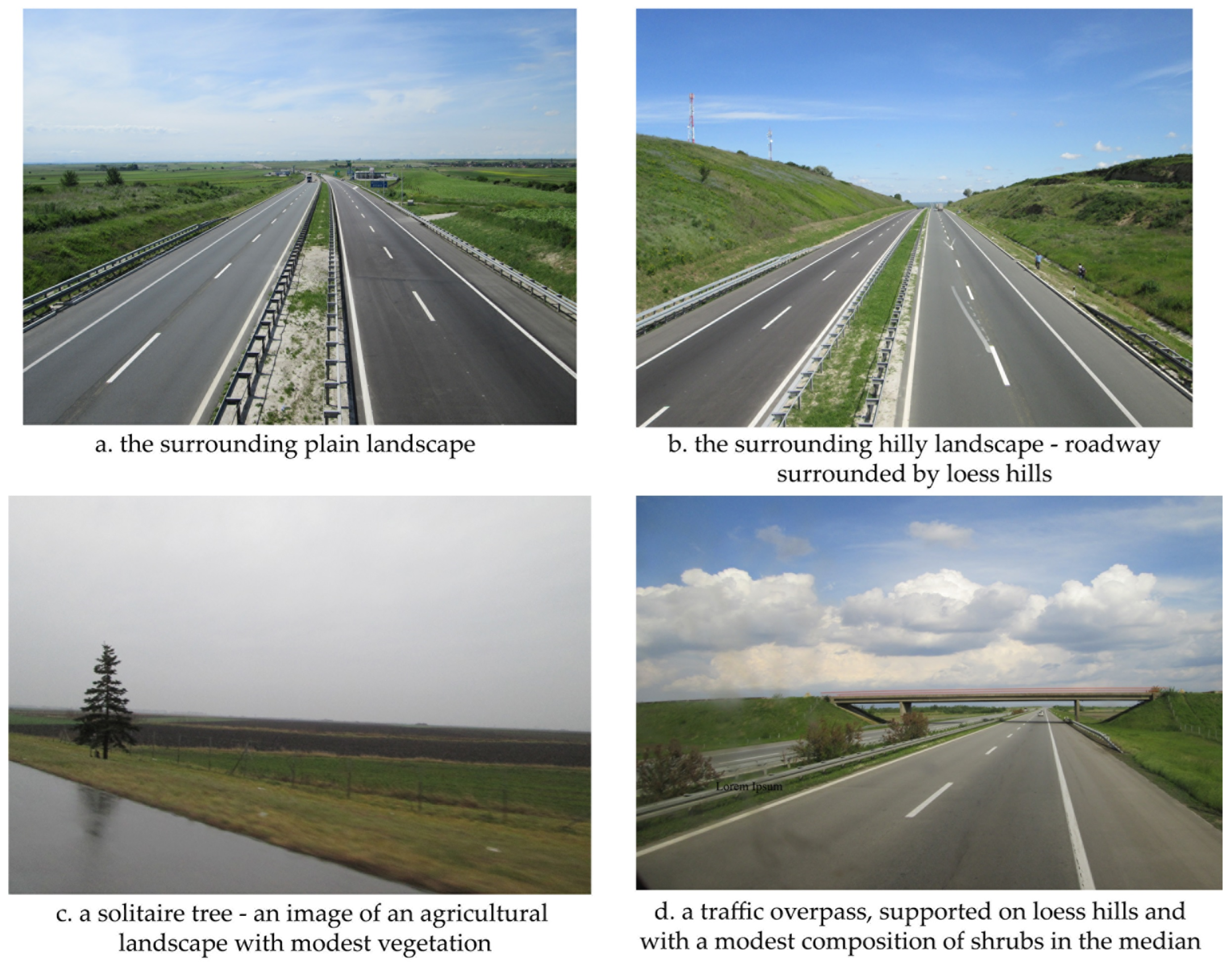
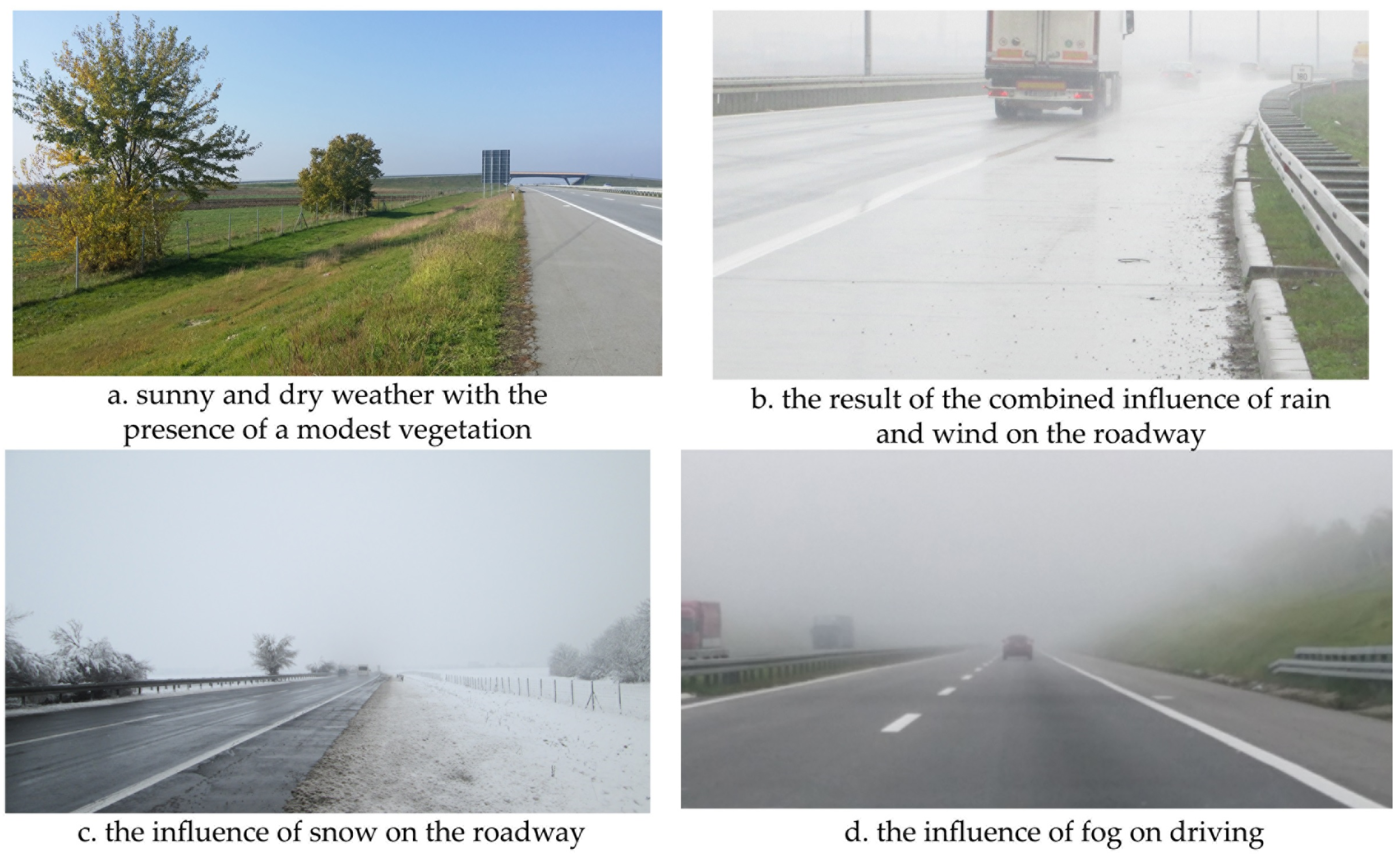
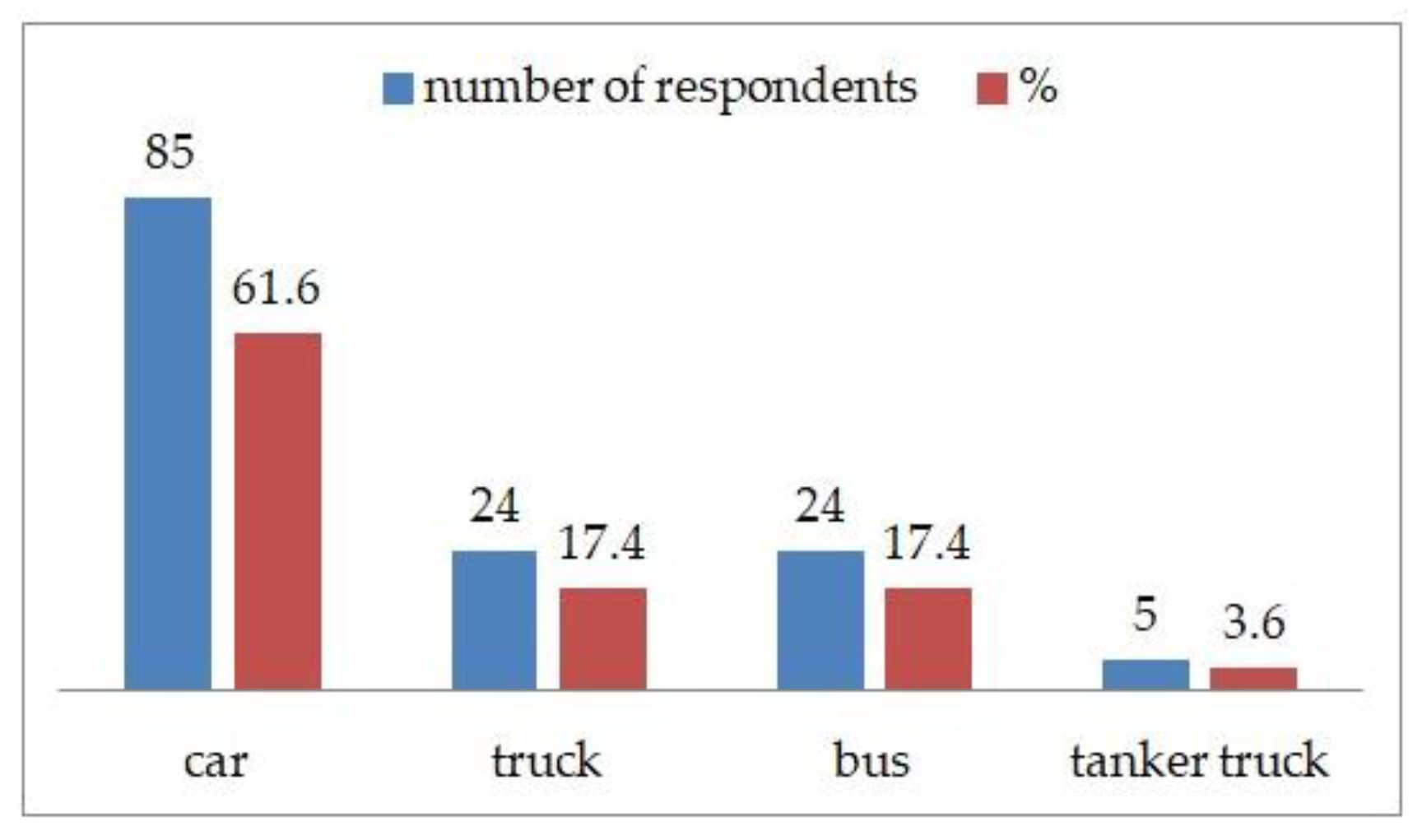
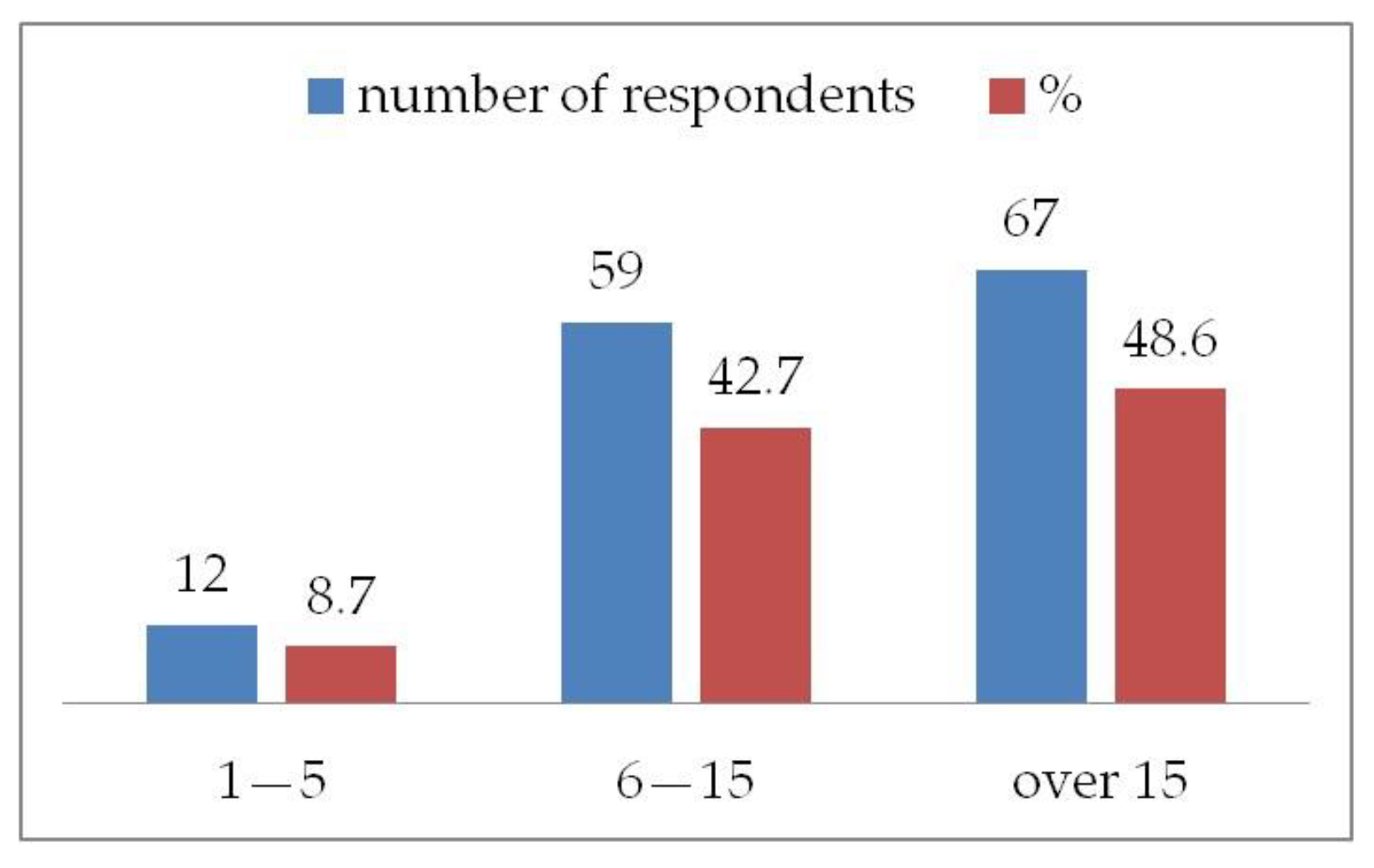
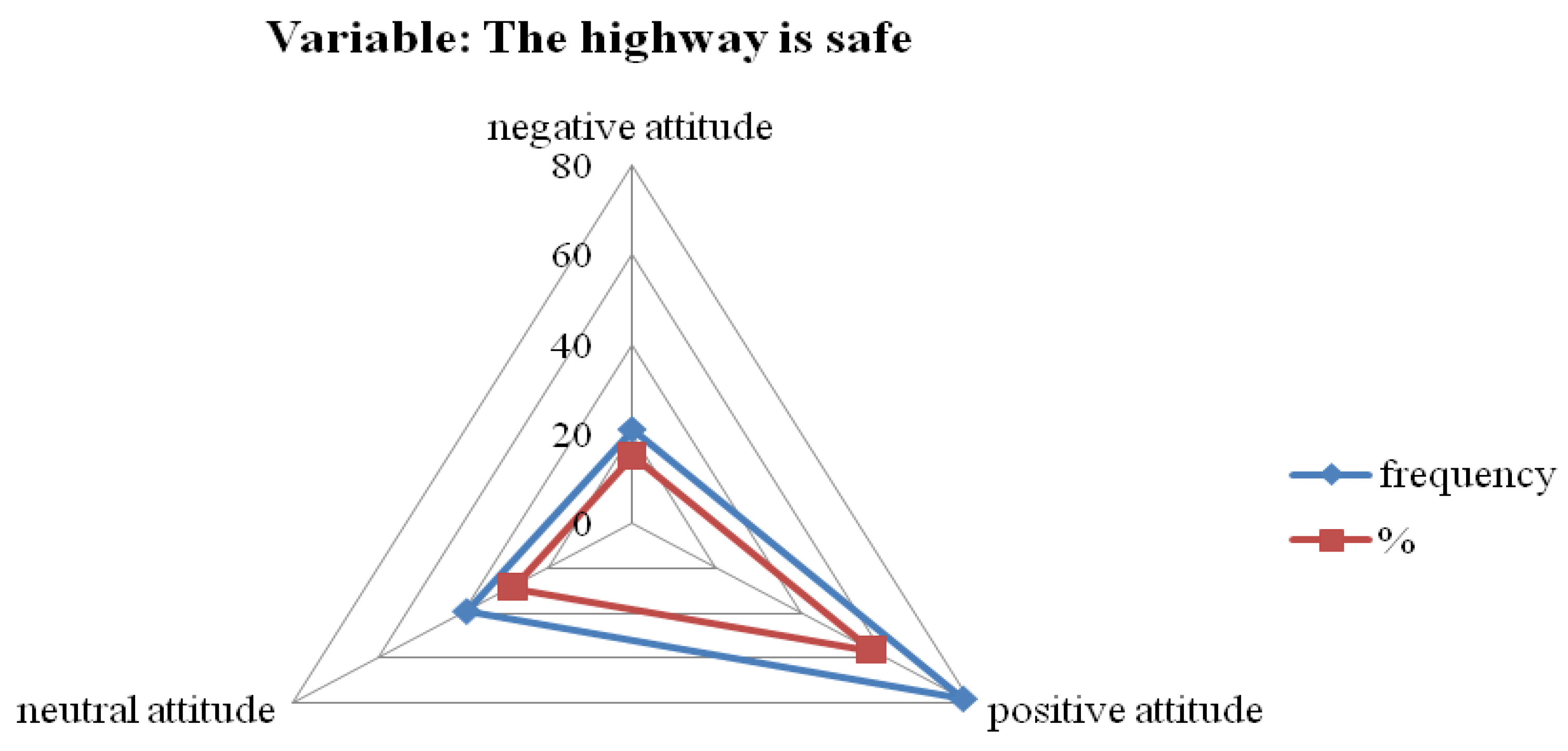

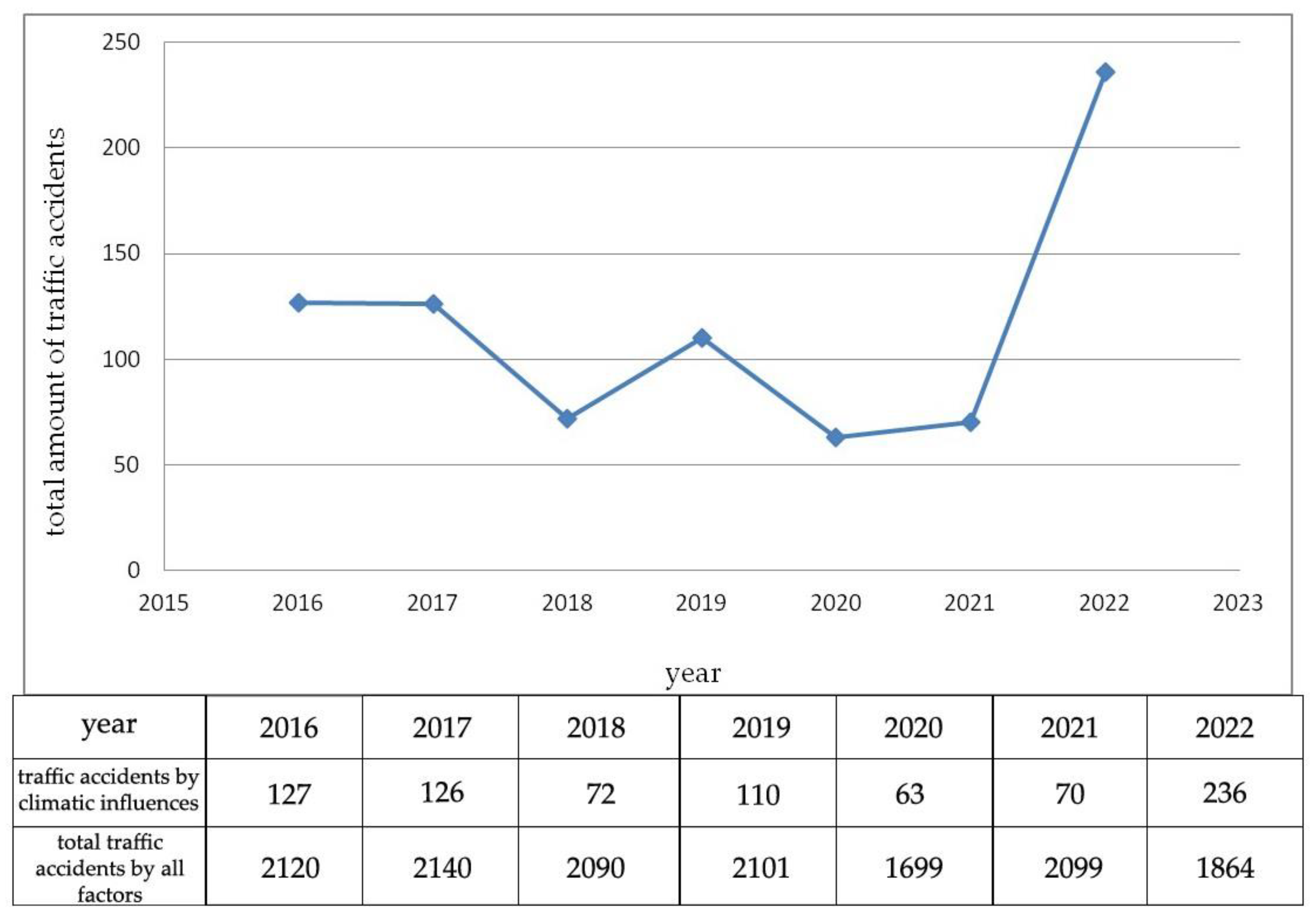
| Descriptive Statistics | N | Min. | Max | Mean | Std. Deviation |
|---|---|---|---|---|---|
| I often drive along the BG–NS highway route. | 138 | 3 | 5 | 3.98 | 0.867 |
| I consider the BG–NS highway route to be safe. | 138 | 1 | 5 | 3.51 | 0.961 |
| Driving is not monotonous along the route. | 138 | 1 | 5 | 2.83 | 1.212 |
| The highway signs are satisfactory. | 138 | 1 | 5 | 3.54 | 0.982 |
| The roadway is free of cracks. | 138 | 1 | 5 | 2.57 | 1.100 |
| The shoulder along the route is safe. | 138 | 1 | 5 | 2.99 | 1.094 |
| The roadway is protected from wind impact. | 138 | 1 | 5 | 2.13 | 1.010 |
| The roadway is protected from snowdrifts. | 138 | 1 | 5 | 2.14 | 1.122 |
| The highway route is always passable. | 138 | 1 | 5 | 3.33 | 1.096 |
| The roadway is protected from reflected sunlight. | 138 | 1 | 5 | 2.69 | 1.119 |
| The highway landscape vegetation does not endanger safety. | 138 | 1 | 5 | 1.95 | 1.069 |
| Vegetation in the highway median does not endanger safety. | 138 | 1 | 5 | 1.87 | 1.017 |
| The highway junction points are safe. | 138 | 1 | 5 | 3.60 | 1.156 |
| The “Kovilj” rest area satisfies the needs of drivers. | 138 | 1 | 5 | 3.06 | 1.289 |
| Animals are not endangered by the highway traffic. | 138 | 1 | 5 | 3.04 | 1.328 |
| The BG–NS Highway: The Examined Variables | Do Not Agree at All | Partly Disagree | Agree and Disagree | Partly Agree | Completely Agree | |||||
|---|---|---|---|---|---|---|---|---|---|---|
| Frequency | % | Frequency | % | Frequency | % | Frequency | % | Frequency | % | |
| The shoulder along the route is safe. | 16 | 11.5 | 20 | 14.5 | 28 | 20.3 | 33 | 24 | 41 | 29.7 |
| The highway signs are satisfactory. | 18 | 13 | 20 | 14.5 | 37 | 26.8 | 28 | 20.3 | 35 | 25.4 |
| The roadway is free of cracks. | 29 | 21.01 | 34 | 24.6 | 46 | 33.3 | 25 | 18.09 | 4 | 2.9 |
| The roadway is protected from wind impact. | 45 | 32.6 | 46 | 33.3 | 32 | 23.2 | 14 | 10.1 | 1 | 0.7 |
| The roadway is protected from snowdrifts. | 53 | 38.4 | 35 | 25.4 | 31 | 22.5 | 16 | 11.6 | 3 | 2.2 |
| The roadway is protected from reflected sunlight. | 23 | 16.7 | 41 | 29.7 | 34 | 24.6 | 36 | 26.1 | 4 | 2.9 |
| The BG–NS Highway | The Highway Signs Are Satisfactory | The Roadway Is Free of Cracks | The Roadway Is Protected From Snow | The Highway Route Is Always Passable | The Highway Junction Points Are Safe | Animals Are Not Endangered by the Highway Traffic | |
|---|---|---|---|---|---|---|---|
| I often drive along the BG–NS highway route | Pearson Correlation (r) | −0.326 ** | −0.301 ** | −0.094 | 0.008 | −0.271 ** | 0.330 ** |
| Sig. 2-tailed (p) | 0.008 | 0.000 | 0.270 | 0.929 | 0.001 | 0.007 | |
| N | 138 | 138 | 138 | 138 | 138 | 138 | |
| I consider the BG–NS highway route to be safe | Pearson Correlation (r) | 0.518 ** | 0.628 ** | 0.307 ** | 0.483 ** | 0.387 ** | −0.513 ** |
| Sig. 2-tailed (p) | 0.000 | 0.000 | 0.000 | 0.000 | 0.000 | 0.000 | |
| N | 138 | 138 | 138 | 138 | 138 | 138 | |
| Group Statistics | |||||||
|---|---|---|---|---|---|---|---|
| Overall safety rating | gender | N | Mean | Std. Deviation | Std. Error Mean | ||
| male | 107 | 2.8491 | 0.43167 | 0.04173 | |||
| female | 31 | 2.6093 | 0.43475 | 0.07808 | |||
| Independent Sample Test | |||||||
| Overall safety rating | Levene’s Test for Equality of Variances | t-test for Equal Means | |||||
| 95% Confidence Interval of Difference | |||||||
| F | Sig. (p) | t | df | Sig. 2-tailed (p) | Lower bound | Upper bound | |
| Equality of variances is assumed | 0.112 | 0.738 | 2.719 | 136 | 0.007 | 0.06537 | 0.41416 |
| Equality of variances is not assumed | 2.708 | 48.466 | 0.009 | 0.06179 | 0.41773 | ||
| Test of Homogeneity of Variances | |||
|---|---|---|---|
| Levene’s statistic | df1 | df2 | Sig. (p) |
| 1.256 | 2 | 135 | 0.288 |
| Analysis of Variances (ANOVA) | |||
| F-test | df | F | Sig. (p) |
| Between the groups | 2 | 3.101 | 0.058 |
| Withinthe group | 135 | ||
| Test of Homogeneity of Variances | ||||||||
|---|---|---|---|---|---|---|---|---|
| Levene’sstatistic | df1 | df2 | Sig. (p) | |||||
| 0.608 | 3 | 133 | 0.611 | |||||
| Analysis of Variances (ANOVA) | ||||||||
| F-test | df | F | Sig. (p) | |||||
| Between the groups | 3 | 6.771 | 0.000 | |||||
| Withinthe group | 133 | |||||||
| Multiple Comparisons: Scheffe Post HocTest | ||||||||
| (I) Motor vehicle | (J) Motor vehicle | Differences between values of arithmetic means (I-J) | Std. Error | Sig. | 95% confidence interval of difference | |||
| Lower bound | Upper bound | |||||||
| Car | Truck | −0.34722 * | 0.09675 | 0.006 | −0.6212 | −0.0733 | ||
| Bus | 0.08333 | 0.09675 | 0.863 | −0.1906 | 0.3573 | |||
| Tanker truck | −0.45370 | 0.19242 | 0.141 | −0.9986 | 0.0911 | |||
| Truck | Car | 0.34722 * | 0.09675 | 0.006 | 0.0733 | 0.6212 | ||
| Bus | 0.43056 * | 0.12066 | 0.007 | 0.0889 | 0.7722 | |||
| Tanker truck | −0.10648 | 0.20549 | 0.966 | −0.6883 | 0.4754 | |||
| Bus | Car | −0.08333 | 0.09675 | 0.863 | −0.3573 | 0.1906 | ||
| Truck | −0.43056 * | 0.12066 | 0.007 | −0.7722 | −0.0889 | |||
| Tanker truck | −0.53704 | 0.20549 | 0.083 | −1.1189 | 0.0448 | |||
| Tanker truck | Car | 0.45370 | 0.19242 | 0.141 | −0.0911 | 0.9986 | ||
| Truck | 0.10648 | 0.20549 | 0.966 | −0.4754 | 0.6883 | |||
| Bus | 0.53704 | 0.20549 | 0.083 | −0.0448 | 1.1189 | |||
| The BG–NS Highway | The Roadway Is Protected from Snowdrifts | The Roadway Is Protected from Reflected Sunlight | |
|---|---|---|---|
| The roadway is protected from wind impacts | Pearson correlation (r) | 0.848 ** | 0.488 ** |
| Sig. 2-tailed (p) | 0.000 | 0.000 | |
| N | 138 | 138 | |
| The BG–NS Highway: The Crossing of Examined Variables | Do Not Agree at All | Partly Disagree | Agree and Disagree | Partly Agree | Completely Agree | |||||
|---|---|---|---|---|---|---|---|---|---|---|
| Frequency | % | Frequency | % | Frequency | % | Frequency | % | Frequency | % | |
| The vegetation in the highway landscape endangers traffic safety. | 58 | 42 | 48 | 34.8 | 18 | 13 | 9 | 6.5 | 5 | 3.6 |
| The vegetation on the highway median endangers safety. | 62 | 44.9 | 46 | 33.3 | 21 | 15.2 | 4 | 2.9 | 5 | 3.6 |
| Animals are not endangered by highway traffic. | 26 | 18.8 | 19 | 13.8 | 37 | 26.8 | 35 | 25.4 | 21 | 15.2 |
| The BG–NS Highway | The Roadway Is Protected from Wind Impact. | The Roadway Is Protected from Snowdrifts. | The Roadway Is Protected from Reflected Sunlight. | |
|---|---|---|---|---|
| The vegetation in the highway landscape endangers traffic safety. | Pearson Correlation (r) | 0.148 | 0.128 | −0.196 * |
| Sig. 2-tailed (p) | 0.083 | 0.136 | 0.021 | |
| N | 138 | 138 | 138 | |
| The vegetation on the highway median endangers safety. | Pearson Correlation (r) | 0.002 | 0.009 | −0.267 ** |
| Sig. 2-tailed (p) | 0.977 | 0.912 | 0.002 | |
| N | 138 | 138 | 138 | |
Disclaimer/Publisher’s Note: The statements, opinions and data contained in all publications are solely those of the individual author(s) and contributor(s) and not of MDPI and/or the editor(s). MDPI and/or the editor(s) disclaim responsibility for any injury to people or property resulting from any ideas, methods, instructions or products referred to in the content. |
© 2025 by the authors. Licensee MDPI, Basel, Switzerland. This article is an open access article distributed under the terms and conditions of the Creative Commons Attribution (CC BY) license (https://creativecommons.org/licenses/by/4.0/).
Share and Cite
Sentić, I.; Živojinović, I.; Đorđević, J.; Tomićević-Dubljević, J. Drivers’ Perspective on Traffic Safety and Impacts from the Surrounding Landscape: A Case Study of Serbia. Sustainability 2025, 17, 1936. https://doi.org/10.3390/su17051936
Sentić I, Živojinović I, Đorđević J, Tomićević-Dubljević J. Drivers’ Perspective on Traffic Safety and Impacts from the Surrounding Landscape: A Case Study of Serbia. Sustainability. 2025; 17(5):1936. https://doi.org/10.3390/su17051936
Chicago/Turabian StyleSentić, Ivana, Ivana Živojinović, Jasmina Đorđević, and Jelena Tomićević-Dubljević. 2025. "Drivers’ Perspective on Traffic Safety and Impacts from the Surrounding Landscape: A Case Study of Serbia" Sustainability 17, no. 5: 1936. https://doi.org/10.3390/su17051936
APA StyleSentić, I., Živojinović, I., Đorđević, J., & Tomićević-Dubljević, J. (2025). Drivers’ Perspective on Traffic Safety and Impacts from the Surrounding Landscape: A Case Study of Serbia. Sustainability, 17(5), 1936. https://doi.org/10.3390/su17051936










